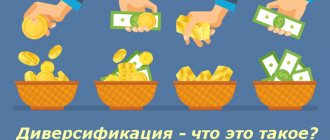Inflation in Russia in 2020 was 2.5%. This is the lowest figure in the country's recent history. What will happen if inflation drops to zero and the reverse process begins—deflation? For the Russian Federation, such a development of events so far looks fantastic, but deflation has happened in the history of some countries. How does it affect the economy? What are the causes of deflation and what are the consequences? Is it easy to deal with them and by what methods?
Why is deflation dangerous for the economy?
On the one hand, increasing purchasing power is good for the population. Yesterday you could buy a conventional kilogram of sausage for 100 rubles, today – already 1.2 kilograms. And if you look from the manufacturer’s side?
Yesterday you received 100 full rubles per kilogram, and today - only 80. Yes, prices for raw materials have dropped, you can try to reduce wages (this is also not always easy to do), but the compression of the money supply will inevitably lead to a slowdown in the development of the enterprise, because it is endless to reduce the price is impossible, let alone the salary. This means that some enterprises will close. But surviving companies will also have to cut production and personnel; a reduction in wages will lead to a reduction in tax contributions and economic stagnation of entire industries.
Causes of deflation
Among the main causes of deflation, the following are worth highlighting:
- banks opening deposit accounts at too high an interest rate;
- an economic crisis due to which a large number of citizens cannot find work;
- incorrect monetary policy, which implies maintaining too high interest rates and using restrictive instruments;
- a sharp change in the money supply, which will certainly affect the price of services and goods;
- large debts that arose against the background of the repayment of large loans with the absence of money emission.
Why does deflation occur?
There are four main reasons for the emergence of deflationary processes in the economy. Here they are:
1Increasing demand for money (both cash and non-cash).
This happens when the stability and predictability of economic development leads to a widespread desire of the population to increase their savings. Moreover, it does not matter whether citizens take money to the bank or keep it at home. In both cases, the money supply is “washed out” of the economy, due to which the value of money increases and the value of goods decreases (purchases are postponed until later). As a result, prices fall, manufacturers reduce prices for their goods in order to increase consumer activity and demand. Another reason for the growth in demand for money is the presence of a “bubble” into which the free funds of citizens and enterprises go. This could be a stock exchange speculative “bubble” or, for example, a currency bubble (with the free circulation of two currencies in the country, it becomes more profitable to invest in one of them, which is why the second is in short supply).
2Reduction in lending.
A decrease in the volume of funds issued by banks in the form of loans also reduces the money supply in circulation. The behavior of the banking sector is dictated by economic conditions or government restrictive measures. In the first case, with zero and negative inflation, interest rates are reduced, and lending ceases to be a profitable business. In the second case, an attempt by the state to limit lending for purchases, for example, real estate during a period of high prices for it, can lead to the collapse of the industry and serious consequences for the entire economy. This, for example, happened in Japan in the early 90s of the last century (this example will be discussed in more detail below).
What is deflation and how does it happen?
Deflation - what is it in simple words? This refers to the process of increasing the real value of money and its purchasing power. This word comes from the Latin “deflatio”, which in Russian translation means “to deflate”. In simple terms, deflation involves a constant fall in the prices of goods and services.
On the surface, increasing the purchasing power of money is a good thing for consumers. Today we buy one kilogram of sugar for 50 rubles, and tomorrow it will be one and a half. But the main catch lies in the reasons that cause this phenomenon, and therefore a decrease in prices. Indeed, sometimes deflation is good, but most often it is bad.
Types of deflation
Good deflation occurs as a result of increasing the efficiency of enterprises, reducing production costs, and increasing competitiveness. In this case, manufacturers lower prices to attract buyers, but this does not eliminate jobs or reduce workers' wages.
However, more often, price reductions occur due to the fact that consumer demand falls, the amount of money in circulation decreases, and its real value decreases, as a result, producers are forced to reduce the number of employees and reduce wages. In this case, deflation clearly signals the beginning of an economic downturn.
Why is it worse than inflation?
In recent decades, in most countries of the world, inflation has been a constant process, and economists believe that normal economic development is impossible without it. But in a number of countries the opposite phenomenon is observed - for example, deflation is widespread in Europe, which has been talked about a lot since 2014.
The annual inflation rate in the range of 1 - 3 percent is considered as a phenomenon inextricably linked with economic growth. As for deflation, even its level of 1-2% per year can cause a serious economic crisis.
If you look at examples in different countries, it becomes clear that deflation can provoke a protracted economic recession. A clear example is the deflation in the United States from 1929 to 1933, which led to the Great Depression. It is precisely because of the decline in prices that the crisis in the United States has taken on a much larger scale than in European countries.
Another example of deflation is associated with the Land of the Rising Sun. In the 90s of the 20th century, deflation in Japan led to the beginning of a period of stagnation, which is commonly called the lost decade.
In Russia, this phenomenon does not occur. At the end of the year, price increases since 1991 have almost always been more than 10%. In the early 90s, annual inflation was characterized by a triple-digit number, when prices increased several times over the year.
For example, in 1992, the annual inflation rate was an incredible 2,600%, or a 26-fold increase in prices!!!
We can safely assume that in the next few years there is no fear of ruble deflation.
Sometimes the media, as soon as a slight decline in prices begins, begins to shout at the top of their voices that deflation has begun. But as a rule, this is a seasonal phenomenon and prices change only in certain categories. A striking example is the autumn harvest. Due to an oversupply on the market, prices fall. But if you look across the entire year, you won’t see anything like this. A continuous rise in prices.
Deflation - the example of Japan
In the 80s of the last century, what is commonly called the “Japanese Economic Miracle” happened in Japan. The fact is that after the war, economic recovery proceeded at an accelerated pace. People worked hard and bought a lot, as a result, the standard of living increased, the population had everything they needed, after which demand began to fall.
This led to a cash deficit - enterprises did not have enough cash, it accumulated among consumers. People were in no hurry to buy new household appliances, furniture, cars; their property was of excellent quality, and there was no need to replace it with new ones.
Manufacturers tried to reduce prices for goods, but the effect was minimal. Perhaps people still didn't see the need to buy or were waiting for prices to drop even lower. Manufacturing companies began to suffer losses. At this time, the government raised taxes to ensure there was enough money in the treasury. As a result, businesses began to close, and those that did not close laid off staff. Investments in industry came to naught, and the economy began to decline.
In 2004, Japan almost managed to overcome deflation, but the crisis of the ninth year and the tsunami in 2011 returned the country to its previous situation.
What are the downsides of deflation?
The consequences of deflationary processes (if deflation is not caused by the development of the economy, but stems from its imbalance) are quite severe. These include the following problems:
1"Deflationary spiral." When prices fall, under the conditions of the savings behavior model of the population, there is no proportional revival of demand. But the profits of enterprises are reduced, which leads to the freezing of development programs and staff reductions, as well as a decrease in the incomes of the remaining employees. As a consequence, there is a further reduction in demand, deflation continues to grow - and so on in a spiral, with each new turn of which the situation gets worse. A similar effect occurs in the sphere of monetary circulation if a massive cessation of the work of banks begins and the population grows distrust of the remaining ones. In this case, people prefer to keep money at home, and the deflationary process increases, depriving the economy of funds for growth.
2Cessation of production development. When profits fall as a result of lower prices and decreased demand, business owners can reduce expenses only to a certain level: it is impossible, for example, to reduce wages significantly. Losses arise, staff have to be cut (this process also has limits) and development programs have to be put on hold.
3Decrease in lending volumes. If the value of the money borrowed is less than the value of the money that will have to be repaid, there is no point in taking out a loan. Therefore, with deflation, accompanied by a decrease in incomes of the population and enterprises, lending freezes.
As we see, the causes and consequences of deflation are mutually determined and interconnected. If the scale of inflation can be reduced by tightening economic rules (for example, raising the key rate and tighter control over banks), then to stop deflation the state has to take more serious measures.
Ways to fight deflation
Deflation is considered a complex and destructive economic process that causes a decrease in the standard of living of the population and a deep crisis in the economy. In the practice of the world economy, this process has been observed rarely, but repeatedly. It may take many years to get out of it. Basic methods of combating deflation:
| Method | Actions |
| Emergency introduction of money supply (money emission) | This is the main method of response. At the enterprise level, this is expressed in attracting additional investment. The leading entity in the state is the Central Bank, which neutralizes the effects of deflation by increasing the money supply. The optimality of money emission is related to the problem of the optimality of money in general and the optimality of the amount of money. Regulated money emission refers to the regulators of the economy and adjusts the phases of business cycles. In this case, the principle of moderate equivalent must be observed. Excessive financing can trigger the reverse process – inflation. |
| Interest rate reduction | Interest rates on loans drop to 0%. This contributes to the restoration of the credit and banking system and the financial condition of business entities |
| Keynes method | This is a temporary concept that is used to achieve a short-term result. A temporary additional source of income is created, for example, an increase in tax burdens, an increase in existing taxes and the introduction of new fees. |
Deflation does not go away on its own. This process requires comprehensive measures at the government level. With a competent strategic plan, you can prevent the consequences of falling prices and consumer demand. Otherwise, a deflationary collapse may occur—the destruction of the state’s industry.
Deflation: examples from history
Throughout the post-Soviet history of its existence, Russia has been tormented by inflationary risks, so for us deflation is rather a theoretical concept. But in order not to be unfounded, we will give two of the most famous examples from the life of other countries that had to feel the consequences of deflation.
"Great Depression" in the USA
The first signs of the economic crisis in North America appeared long before 1929, when it broke out in full force. Economic growth (from 1913 to 1927, US national income almost tripled) was accompanied by rapid growth in the speculative sector. Every fourth American participated in stock market games. The money supply was growing (it increased by 60% the year before the crash); the country experienced a boom in credit purchases at low rates.
At the same time, already from the end of 1925, the pace of construction and production of machines slowed down: due to the flow of funds into the consumer and financial sectors, there began to be a shortage of money supply for investment in fixed assets.
As the economy slowed, the Federal Reserve tried to galvanize it by lowering the refinancing rate. This further stimulated lending, but the money supply went to the stock exchange and became increasingly unsecured. This had a negative impact on the prospects of the economy, since the dollar exchange rate was strictly tied to the price of gold, and it was impossible to simply print money.
In 1928, the Fed tried to reduce the injection of “empty” money into the economy as much as possible in order to prevent further inflating of the stock market bubble. The interest rate on the loan increased, protectionist measures led to an increase in local production, which was not met by demand. Inflation dropped sharply almost immediately, and the shortage of national currency for financial transactions began to be felt more and more.
The demand for company shares fell (there was simply nothing to buy them for), and after them, prices for real products traded on the stock exchange began to sharply decline. On October 29, 1929, “Black Tuesday” happened: brokers put more than 16 million shares on sale - by the end of the day they were selling for next to nothing. The country's market capitalization fell by 15%.
Over the next week, deflation swept through all sectors of the economy. Prices for basic goods that formed the skeleton of the US economy at that time fell tenfold: wheat, cotton, fuel. Over three weeks, the loss amounted to about 30% of the country's GDP.
Depositors tried en masse to withdraw their deposits. As a result, banks, which had lost a significant part of their liquidity, stopped lending to clients. This led to the bankruptcy of hundreds of businesses. By 1932, about 10% of the US population was unemployed. A sharp decline in household and business incomes led to an avalanche-like reduction in demand and money supply in the country.
The government tried to stop the crisis by cutting taxes and increasing government spending. The latter method brought results - however, only a few years later, when Franklin Roosevelt became president, implementing his famous “New Deal”. The dollar was devalued and it ceased to depend on the price of gold.
Banks received significant government funds (in particular, government bonds were purchased, the only remaining liquid securities). The specially created National Administration for Industrial Recovery took control of the main markets: it was in charge of distributing quotas for the production of certain types of products (to avoid overproduction), setting prices for socially significant goods, determining credit conditions mandatory for all banks, and so on. .
By 1937, the crisis had subsided, deflation approached its minimum level, gradually turning into inflation.
Japan's "Lost Decade": 1990s
The Japanese economic miracle, which so surprised the world in the second half of the 20th century, also had its unexpected consequences. When the level of income of the population increased significantly, and the demand for basic necessities was generally satisfied, the Japanese Central Bank began to implement a policy of stimulating savings. As a result, along with bank deposits, the securities market began to grow sharply: free funds of the population and businesses went there. The increase in the profitability of the stock market led to the flow of not only free funds into speculative instruments, but also money intended for investment projects: it became more profitable for companies to make profits through financial transactions rather than through the real sector.
The real estate and construction sectors, as well as the stock market itself, traditionally “inflated” faster than others. The growth of construction lending at low rates led to a sharp increase in real estate prices, and industrial indices began to slow down significantly.
The Japanese government tried to limit the speculative market by increasing the key rate. However, this only led to the fact that, having reached their peak in 1989, the real estate and construction markets went down, eating up investments in these sectors and “squeezing” the money supply in the country. By 1993, prices in these areas had tripled, and investors lost billions of yen. This significantly slowed down already sluggish consumer behavior, resulting in a prolonged decline in other industries.
Deflation continued until 2004. Then there was a small surge associated with the introduction of inflation targeting (the Central Bank of Japan began to strictly regulate the interest rate, slightly reviving the economy), but after the global economic crisis of 2009, the country again fell into a period of deflation, which continues with short breaks to this day. This significantly slows down economic growth (since 2011, it has never exceeded one and a half percent).
How deflation affected world states
The process of increasing the cost of money is not new; it has accompanied the development of the world economy for many decades. Deflation can be seen at various points in the development of the economy of a number of countries, if you start studying this issue.
During the Great Depression, when the New York Stock Exchange crashed in 1929, many financial institutions went bankrupt and customers lost all their deposits. This circumstance caused an impressive rise in the price of the currency, due to the artificial creation of a “credit bubble” and its inevitable explosion.
Another significant situation occurred in Japan, where in the late 1980s the government artificially increased the demand for real estate, which caused a significant increase in prices. Thus, the land under the imperial palace was worth approximately the same as the entire territory of the American state of California. It was impossible to maintain price increases for a long time, the bubble burst, after which there were numerous cases of bankruptcy of credit institutions and a drop in loan capital. Then the Japanese authorities again tried to carry out this procedure, but credit institutions and industry no longer wanted to participate in the scam. As a result, modern Japan has an extremely low demand for real estate and land, despite the small scale of unoccupied territories, whose value is declining every year.
To summarize, we can note a rather difficult definition of the concept of deflation, which is not so easy to explain in simple words. Obviously, this is a process of increasing the price of a currency, created artificially (by removing a certain amount of money from circulation) or naturally, by increasing the volume of production of goods and services.
In each situation, currency deflation has a strong impact on both production and the population, affecting the budgets of both ordinary citizens and entire countries. In Russia, this process happens extremely rarely, but some world states have already felt the full consequences of deflation.
How to beat deflation
There are several ways to reduce the negative consequences of deflation and reverse the process.
1Reducing the tax burden.
Reducing the tax burden usually revives the investment activity of an enterprise and gives it a certain margin of safety even in a crisis of overproduction.
2 Stimulating lending.
If the state or the banks themselves take steps towards lowering the interest rate on loans for end consumers, reducing requirements for borrowers and improving loan conditions, then the economy receives a serious influx of “real” money and an increase in demand for certain groups of goods, which can become drivers, leading the country out of stagnation.
3Stimulating infrastructure development.
This is usually done by the state. If the economy is stagnant, large infrastructure projects are launched to build roads, bridges, gas pipelines, and so on. The construction of these objects requires a large amount of building materials, and accordingly, the sphere of their production comes to life. The growing incomes of workers at the enterprises involved increase the demand for goods, and other market segments are also becoming more active.
4Tax preferences for large investors.
If the state is ready to provide benefits to large companies in exchange for participation in infrastructure and large investment projects, the process of overcoming the consequences of deflation will go even faster.
Definition and essence of deflation
Deflation is the opposite of inflation, a rare but significant tendency to lower average prices for goods and services. Unlike inflation, the impact of which is first felt by the population, deflation first of all affects banks and enterprises, and then affects citizens. What deflation and inflation have in common is that both processes are signs of problems in the economy.
The state's financial policy during deflation assumes:
- reducing inflation below zero;
- withdrawal of money from circulation;
- increased control in the foreign exchange and trade spheres;
- issue and sale of government securities;
- tax increases;
- preventing wage increases;
- reduction of state budget expenditures.
In addition, deflation involves an increase in the real value of money and its purchasing power. This situation is dangerous for the economy, as it causes an increase in unemployment and a high risk of business failure.
Due to the artificial decrease in money in circulation, the deflation coefficient increases, and this is considered the beginning of a period of general decline in the economy. The main reason for deflation is a shortage of cash, a decrease in workers' wages and recessionary processes in industry, that is, a reduction in production.
Signs of the deflationary process are:
- falling consumer demand;
- reduction in wages of workers;
- rapidly increasing unemployment;
- reduction in prices for products produced by national enterprises.
The Consumer Price Index allows you to take into account how the real income of the population has risen or fallen. It affects stock market and securities market rates, interest rates on loans and is used in calculating the indexation of pensions, benefits and wages of public sector employees.
FAQ
Why is deflation worse than inflation?
In a market economy, the most suitable state for economic growth is considered to be inflation of 1-3% per year. This indicator ensures a smooth and painless flow of funds from the population to the disposal of business, due to which the latter develops, after which the standard of living of the population “pulls up” to the increased level of economic development. Significantly higher inflation becomes sensitive for citizens, worsening the standard of living and reducing purchasing power - this leads to an imbalance in the economy.
But deflation is considered dangerous for the economy, even if it does not exceed 1-2%. Lower prices with reduced demand quickly lead to a drop in producers' incomes. This causes a chain reaction throughout the economy, and, as mentioned above, the reaction proceeds in a spiral, worsening the economic situation with each turn, and changing this dynamics is more difficult than coping with inflation.
Is deflation threatening Russia?
Just a few years ago, the answer to this question would have been clearly negative. In 2014, inflation in the Russian Federation exceeded 11%, and in 2015 it almost reached 13%. However, already in 2016 this figure was 5.3%, and in 2017 it was slightly higher than 2.5%. Continuation of such dynamics could lead to deflation. However, the Russian economy has its own characteristics that make such a development unlikely. Despite the fairly stable ruble, its exchange rate is tied to the dollar and the price of oil.
Accordingly, internal economic processes affect inflation to a lesser extent than external ones, and even excessively drastic measures to curb inflation, if taken, are unlikely to swing the pendulum in the opposite direction.
The possibility of deflation in the Russian Federation is also countered by the absence of a serious exchange “bubble” - for example, such as the “GKO pyramid” was in the late 90s, and the real estate market was in 2008. The value of enterprise assets more or less corresponds to their real value, so any sharp drops in entire industries at once (as happened in Japan with the construction and real estate markets) cannot happen.
Another important point is the consumer behavior of the population. It is radically different from the Japanese: for the Russian mentality, the logic like “if prices start to decline, let’s wait to make purchases until prices fall completely” is incomprehensible. In the Russian Federation, almost any significant reduction in prices gives rise to rush demand. Perhaps in the future the logic of consumers will change, but today it is like this.
And finally, the last argument. Until now, only two serious historical examples of deflation were known in the world - in the pre-war USA and in Japan in the 90s. Europe is now close to zero inflation, with prices in various industries often falling for a long time. However, such periodic deflation, although it reduces the pace of economic development, does not lead to serious crises. There is no reason yet to believe that things will be any different in Russia.
Inflationary and deflationary processes in the global economy
The causes of inflation are considered to be two concepts:
- Monetary. Supporters of monetary factors believe that the cause of inflation is money: an increase in the money supply in circulation;
- speed of circulation of funds.
- increase in production costs (construction, equipment, etc.);
In modern economic practice, there are two serious examples of the deflationary process - in the United States during the pre-war years of the Great Depression and in Japan in the late 90s. Europe these days is not far from zero inflation; prices in some industries have been declining for a long time. Such deflation is not a sign of a serious crisis, although it reduces the rate of economic growth.
Even in the most developed countries of Europe, the inflation rate is from 1% to 5% and depends on GDP growth and a general increase in living standards. If inflation of 2% is considered the norm in the United States and Europe, then deflation of 2% can cause a serious crisis in the economy, which can undermine economic stability.
Major deflations in the US
The United States has experienced four periods of devastating deflation:
- In 1818 - 1821. The cost of agricultural products decreased by 50%. The contraction of credit that caused the financial crisis in England led to a significant reduction in specie in the United States, and the bank also stopped providing funds.
- In 1830 - 1843. This deflation fully satisfies both signs, that is, a collapse in commodity prices and a decrease in the available amount of money.
- In 1873 - 1879. The third was after the Civil War and is sometimes called the “Great Deflation.” It was caused by a return to the gold standard and the withdrawal from circulation of paper money printed during the Civil War.
- In 1930 - 1933. These years were called the “Great Depression.” The Fisher equation describes the equilibrium between the money supply and the rate of turnover of funds with the price level and the volume of production. In terms of this equation, there was a significant decline in the money supply, and deflation took hold despite the money issued by the Federal Reserve. At this time, the following was noted: a large lack of cash in circulation;
- bankruptcy of most enterprises;
- the collapse of the banking sector and related banking operations;
- average price reduction by 10%;
- the maximum unemployment rate is 25%.
Deflation in Japan
The most serious deflation of modern times occurred in Japan. In the 90s of the 20th century, the production crisis and large injections of Chinese and American capital into the economy led to a rapid drop in the value of Japanese goods. It took about 10 years to get the economy to develop. A technological revolution took place in Japan, which dramatically increased the standard of living of the population.
Just something complicated
The easiest way to explain the concept of deflation is using the example of the price level of essential goods. For example, yesterday a kilogram of sausage cost 500 rubles, but today its cost has dropped to 400 rubles.
Naturally, this will seem like a blessing to the average buyer, but the global reasons that led to a decrease in the cost of sausage are very serious and will have an extremely negative impact on the population in the near future.
The most famous case of real deflation occurred in the United States during the Great Depression (30s of the 20th century). In those days, in order to attract at least some visitors to restaurants, menu prices were changed daily (the cost of dishes was reduced by several cents a day).
Money as debt[edit]
In the modern global financial system, 95% of the total money supply consists of loans (debts). Thus, the classic printing of money (notes, coins) by government financial authorities does not necessarily lead to an increase in consumer prices, and the withdrawal of this physical money does not necessarily lead to a fall in prices. For example, the US banking system holds $8 trillion in consumer deposits, but at the same time there is only $277 billion in cash in all US banks. The rest is loans taken and repeatedly deposited in banks in the accounts of legal entities and individuals.
A correct understanding of the meaning of the terms “inflation” and “deflation” helps to understand why all the efforts of governments to stimulate the economies of their countries: 1) do not lead to an increase in consumer prices; 2) do not work as incentives. This happens because the destruction of capital through bankruptcies, loan defaults, and falling asset prices and stock markets is a much more powerful lever for reducing the monetary base in the economy than multibillion-dollar attempts by governments to stimulate lending.
Modern media and government agencies (controlled by the international Jewish banking mafia) all unanimously intimidate the population with the “danger” of deflation, justifying this by the fact that deflation leads to a decrease in production and economic recession, since no one will want to invest money in production when prices are falling and shrinking profits. But firstly, they do not provide any evidence for this, and secondly, deflation is a consequence, and not the cause, of an economic recession, since when there is an overproduction of goods and services in the economy, a situation arises in which producers cannot sell their goods or speculators cannot find another fool willing to buy a speculative asset from them, such as real estate, raw materials, etc.; this leads to a series of bankruptcies, a reduction in the monetary base in the economy and deflation.
The Jewish banking mafia exists by squeezing interest out of loan borrowers. Debts issued with money taken out of thin air are paid with the real sweat and blood of ordinary people producing a real and tangible economic product. But since the whole world is stuck on the debt needle of banks, the speculative demand for basic goods and assets is growing faster than the average person can save, forcing him to take out even more loans from banks in order to either pay off old debts or to buy something he needs. that he no longer has time to save money by simply putting it aside.
Positive effects of deflation
But this process also has positive consequences. If consumer behavior is not designed for a long wait, then seeing prices drop, the consumer begins to invest his savings and the total amount of money in the economy does not decrease, but increases.
Such situations become possible when deflation becomes a consequence of intensive economic development, the emergence of new types of products, increased efficiency of business processes and labor productivity.
Negative consequences of deflation
During the process of deflation, consumer interest decreases; seeing the forecast for the level of deflation and anticipating a further decline in prices, the buyer does not purchase the goods he needs, especially expensive ones, today, assuming that after a certain time he will be able to purchase more with his savings. At the same time, the manufacturer suffers; if previously he received 10 thousand rubles for a thousand bricks, today he can only ask for 8 thousand for the same thousand bricks. At the same time, the rate of the bank loan taken by him does not decrease.
Further consequences are as follows: demand decreases → total sales volume decreases → production capacity has to be reduced → mass layoffs begin. In addition, the total amount of money in the economy decreases, taxes are reduced. This means that the state finds itself in a situation of budget deficit, because the size of pensions and payments to employees of budgetary institutions, prices for previously concluded government contracts, and interest payments on government bonds cannot be reduced. Construction is slowing down and rents are expensive, projects are being closed. This leads to the fact that the turnover of the oil and gas industry and the electric power industry begins to decline, because the country no longer needs as much fuel and energy.
It is clear that such negative processes are only possible when deflation is prolonged and consumers are actually willing to wait a long time to start purchasing.











